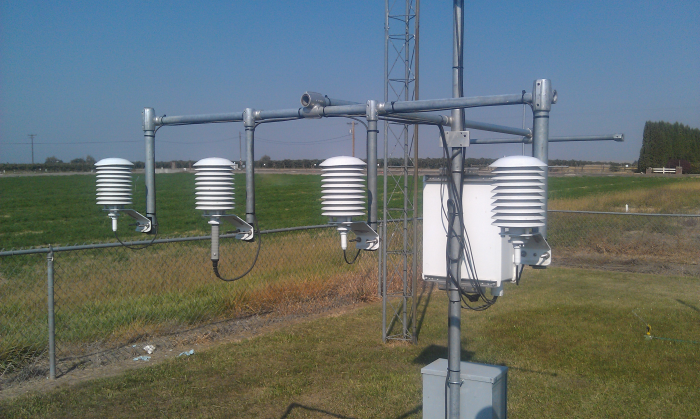


ワシントン州立大学の AgWeatherNet (AWN) は、ほぼ完全に Campbell Scientific 製品で構成された大規模な自動化ネットワークです。AWN の目的は、州全体の現在および過去の気象観測を提供することです。これらの観測は、勧告、気象データ製品、意思決定支援システム、モデルとともに、農業生産と製品品質の向上、資源利用の最適化、環境への影響の軽減に役立つように設計されています。
現在、AWN には 160 を超えるステーションがあり、主にワシントン州東部の灌漑地域にあります。AWN はこのネットワークを拡大し続けており、最終目標は各郡に少なくとも 1 つのステーションを設置することです。最初のステーションは 1988 年に設置され、ネットワークはワシントン州西部と州の乾燥地域に拡大しました。すべてのステーションには、気温、相対湿度、露点温度、土壌温度 (8 インチ)、降雨量、風速、風向、日射量、葉の湿り具合など、一連の標準的な変数があり、一部のステーションには気圧などの追加センサーがあります。変数は、5 秒のスキャン レートに基づいて 15 分間隔で記録されます。すべてのステーションには CR1000 があり、太陽光で充電されます。
ほとんどの観測所には携帯電話モデムのテレメトリが備わっています。データ、およびデータに基づくモデルやツールは、ウェブサイト ( weather.wsu.edu ) で継続的に更新されます。
このネットワークの背後にあるチームは、ワシントン州プロッサーにある WSU 灌漑農業研究普及センターを拠点としており、WSU の農業、人間、自然資源科学部のあらゆる部門と研究普及センターが実施する研究、普及、指導活動にリンクしています。
AgWeatherNet は果樹栽培者から最も強く支持されています。AWN は土地所有者の要請に応じて設置および保守サービスも提供します。
AWN のメンテナンス プログラムは非常によく練られています。ハードウェアはすべて個別にバーコードが付けられ、履歴全体が追跡されています。故障した機器をすぐに交換できるように、常にスペアを用意しています。センサーが入荷すると、修理または交換され、後で配備できるように在庫として入れ替えられます。独自のキャリブレーションと徹底的なテストを実施しています。たとえば、センサー間の精度を調べるために、107 のアレイを同じ場所に設置しています。HMP45C は長い間使用しており、Campbell Scientific が代替品として HC2S3 を導入したとき、すぐに数個購入して、3 つの HC2S3 センサーのデータと同じ場所に設置された HMP45C と比較するテストをセットアップしました。温度、湿度、風速と風向をテストおよびキャリブレーションする機器も備えています。
AgWeatherNet の重要な特徴の 1 つは、データを提供するだけでなく、そのデータに基づいて特定の関心事に関する意思決定支援モデルとツールも提供することです。たとえば、熟したサクランボに雨が降るとサクランボが割れる可能性があるため、栽培者は夜間に 0.1 インチを超える雨が降った場合にテキスト メッセージと電子メールでアラームを送信するよう求めています。その他のモデルには、ブドウの耐寒性やリンゴの花粉管の成長などがあります。